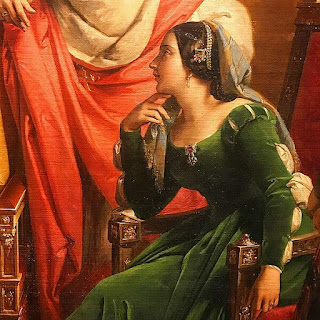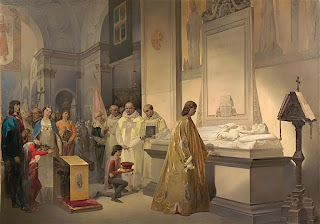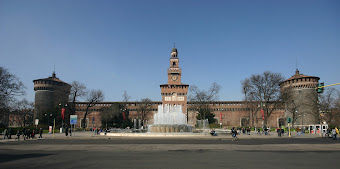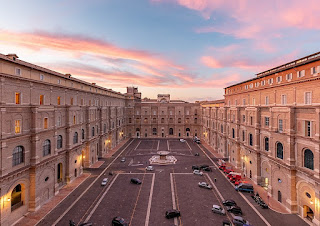The brief life of a politically astute noblewoman from Ferrara
 |
| Beatrice D'Este, portrayed in a painting by the 19th century Italian artist Francesco Podesti |
The Duchess was said to have shown great courage during the Milanese resistance against the French in what was later judged to be the first of the Italian Wars. At the time of the French advance on Milan, with her husband ill, Beatrice made the right decisions on his behalf and helped prevent the Duke of Orleans from conquering her adopted city.
Sadly, she died when she was just 21, after giving birth to a stillborn baby.
Beatrice was born in the Castello Estense in Ferrara in 1475, but spent her early years growing up in her mother’s home city of Naples. When she was 15, her family sent her to marry the 38-year-old Ludovico Sforza, nicknamed Il Moro - The Moor - because of his dark complexion, who was acting as regent of Milan on behalf of his nephew, Gian Galeazzo Sforza.
Ludovico and Beatrice’s wedding celebrations were directed by Leonardo da Vinci, who worked at the Castello Sforzesco in Milan for 17 years, designing elaborate festivals for the Sforza family as well as painting and sculpting.
Ludovico became Duke of Milan after Gian Galeazzo died in 1494, seemingly of natural causes. However, it was rumoured at the time he had been poisoned by his uncle.
 |
| Ludovico Sforza, to whom Beatrice was betrothed at 15 |
As well as associating with Da Vinci and the architect, Donato Bramante, she spent time with poets such as Baldassare Castiglione and Niccolò da Correggio. Her husband seemed to have been genuinely fond of her, despite having a string of mistresses, and once described her as ‘happy by nature and very pleasing.’
Beatrice was trusted to represent her husband as an ambassador to Venice and she also attended a peace conference, along with many powerful political figures of the day, including Charles VIII, King of France.
She gave birth to two sons, Massimiliano, who was born in 1493, and Francesco, who was born in 1495. They each, in turn, went on to become the Duke of Milan.
Beatrice was on course to make Milan one of the greatest Renaissance capitals of Europe when her life ended abruptly.
Pregnant for the third time, she seemed to be in good health when she was seen out in her carriage on January 2, 1497.
 |
| Ludovico Sforza mourns his wife's death by her tomb in the church of Santa Maria delle Grazie |
After saying her prayers in the church, Beatrice returned to the Castello Sforzesco, where she was said to have taken part in dancing during the evening. Afterwards, she started to suffer stomach pains and she gave birth to a stillborn son. She never recovered from the birth and died half an hour after midnight, on January 3.
Later that day, her heartbroken husband wrote about the sad news to his brother-in-law, Francesco II Gonzaga, who was married to Beatrice’s sister, Isabella. He asked for no visits of condolence, saying he wanted to be left alone to grieve. He remained locked in his apartment for two weeks and when he reappeared, he had shaved his head and was dressed in black, wearing an old, torn cloak.
The beautiful Beatrice has been immortalised in sculptures and paintings and has gone down in history as ‘a virago who showed the courage of a man’, during a time when Milan was at war.
 |
| The Castello Sforzesco in Milan, almost 600 years old, is one of the largest castles in Europe |
One of the main sights in Milan is the impressive Sforza castle, Castello Sforzesco, built by Francesco Sforza, Duke of Milan, in 1450. After Ludovico Sforza became Duke in 1494, he commissioned Leonardo da Vinci to fresco several of the rooms. The castle was built on the site of the Castello di Porta Giovia, which had been the main residence in the city of the Visconti family, from which Francesco Sforza was descended. The Viscontis ruled Milan for 170 years. Renovated and enlarged a number of times in subsequent centuries, it became one of the largest citadels in Europe and now houses several museums and art collections. The Cairo metro station is opposite the main entrance to Castello Sforzesco, which is about a 20 minute walk from Milan’s Duomo.
 |
| Leonardo da Vinci's The Last Supper, which he painted on the wall of the refectory |
Santa Maria delle Grazie, a church and Dominican convent in Milan, is home to Leonardo da Vinci’s masterpiece, The Last Supper - Il Cenacolo, which is on the wall of the refectory where the monks used to eat their meals. Entrance to the refectory is now limited to 25 people at a time for a maximum stay of 15 minutes and it is necessary to book a visit in advance. In addition to Il Cenacolo, the church also has a chapel decorated with the frescoes Stories of Life and The Passion of Christ, by Gaudenzio Ferrari and other works by Ferrari, Titian and Bramantino. Titian’s painting, The Coronation of Thorns, once hung in the same chapel as the Ferrari frescoes but is now in the Louvre, in Paris.
Also on this day:
106BC: The birth of Roman politician and philosopher Cicero
1698: The birth of opera librettist Pietro Metastasio
1785: The death of composer Baldassare Galuppi
1877: The birth of textile entrepreneur and publisher Giovanni Treccani
1920: The birth of singer-songwriter Renato Carosone
1929: The birth of film director Sergio Leone
1952: The birth of politician Gianfranco Fini

.jpg)











